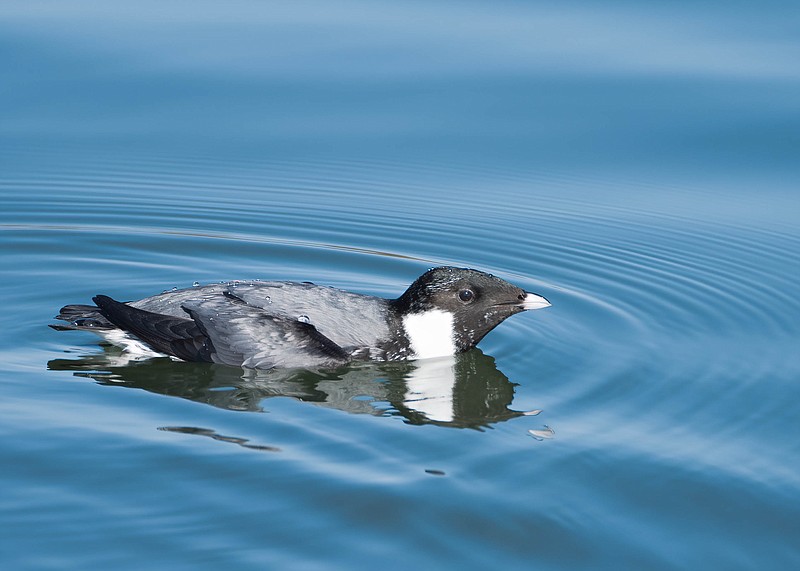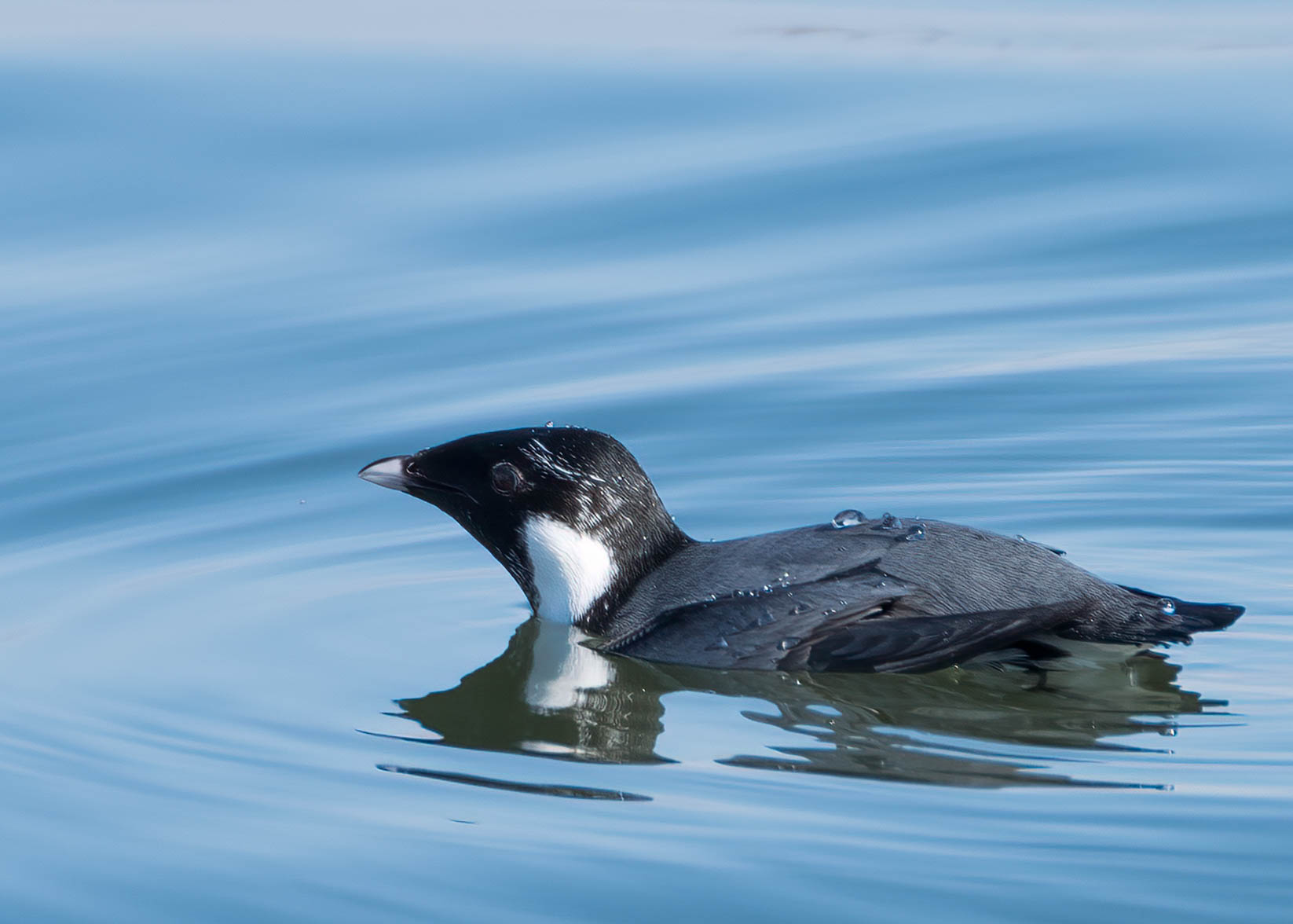When a pair of Lobelville, Tennessee, brothers heard about the first-ever sighting of an ancient murrelet diving bird from the Pacific Coast in Tennessee, they were on the chase of a lifetime halfway across the state with a clock ticking its way to sunset.
Victor and Ruben Stoll are members of an expansive online community of birders — what bird fans often call themselves — who are ruffled with excitement over a rare bird spotted on Chickamauga Lake in Chattanooga.
The ancient murrelet's year-round range stretches mostly along the western Canadian coast, the southern coast of Alaska and the Aleutian Islands, according to the National Audubon Society's species list. The confirmed sighting near Chickamauga Dam is the first documented in Tennessee, more than 2,000 miles from its traditional territory.
Victor Stoll and his brother, Ruben Stoll, found themselves tracing a speedy path to Chickamauga Lake, according to an account given by Victor on social media.
"When an ancient murrelet in breeding plumage was spotted yesterday on Chickamauga Lake in Chattanooga, it triggered one of the wildest, most stressful chases in my birding career," Victor Stoll said in his post. "We were at home when I saw the message at 1:45 p.m. Chattanooga time. I yelled for Ruben and made a wild scramble to grab my scope and camera and get in the car before Ruben could leave without me."
Ancient murrelet
— Conservation status: Still reasonably common, but has been declining for many years. Foxes and raccoons, introduced for fur production, and rats, introduced accidentally, have wiped out or reduced nesting populations on many islands in both North America and Northeast Asia.
— Family: Auks, murres, puffins.
— Habitat: Open ocean, sounds, rarely salt bays. Mostly on cool waters out of sight of land, sometimes concentrating over the edge of the continental shelf; may feed close to shore, especially in straits or near islands where tidal currents concentrate food near the surface. Nests in burrows on islands with a good cover of grass, shrubs and trees.
— Migration: Some remain all year off southern Alaska, while others move south to waters off California in winter. The bird disperses widely at sea after breeding. Of North American auks, the murrelet is most likely to appear far inland. Records exist for many states and provinces east to Quebec and New York, south to Nevada and New Mexico. A few such records occur virtually every year, most in October or November.
— Breeding: Males sing at night from tree branches and other high perches at nesting colonies; the species regularly raises two offspring while most other auks raise only one; it raises its young at sea, leading them away from the nest within a few days after they hatch. The name "ancient" comes from the gray back with a fancied resemblance to a shawl draped across an elderly person's shoulders.
Source: The National Audubon Society
Stoll painted a vivid picture of the chase.
"Knowing it was a slim chance to make it before dark, the car was launched in a spray of gravel," Stoll said. "With an ETA of 5:10 p.m., sunset at 5 p.m., and the nightmarish disaster that is Chattanooga evening traffic, we strapped in and hung on for dear life while Ruben proceeded to break land speed records."
But the anticipated Chattanooga traffic snarl wasn't so bad, and the brothers ended up reaching their destination almost 30 minutes ahead of schedule. But they trailed the ancient murrelet that was set to lead them on a merry chase.
(READ MORE: Rare birds of the Tennessee Valley)
"Feeling like a yo-yo in a horror movie," Stoll said in the post, describing the chase to and fro after reported sightings of the bird.
Finally, they spied their elusive target.
"I spotted the slippery little s—- way down the shoreline," Stoll said in his post. "What a huge relief, and an incredible record. A seabird that breeds on rocky islands off of Alaska, with no previous records in the Southeast. A couple minutes later it flew away to roost somewhere up the vast lake. So close to missing it completely. I can't think of a better or more exciting way to end the day."
On the website eBird.org, more than 250 sightings of the small bird have been reported on Chickamauga Lake since Nov. 24.
(READ MORE: Photos: Rare snowy owl spotted in Chattanooga)
Kirk Huffstater heard the winged visitor had been spotted at the day use area at Chickamauga Dam on Friday, but he couldn't make the trip to Chattanooga from his home in Morristown until visiting relatives went back home after Thanksgiving.
He found it Monday, thanks to fellow birders.
"A lot of times when people are birding, rare birds or even regular birds, they do reports on eBird, which is a free program from Cornell University that tracks birds and tracks the lists of sightings of birds," Huffstater, a member of the East Tennessee Birding Facebook group, said in a phone interview. "It's one of the biggest citizen science projects in the world. When people log that, they log whatever birds they see. The system will automatically flag rare birds."
Huffstater gets regular reports through eBird, and he used the reports to find the bird's most recently known location.
"Quite often when a bird like this shows up, it's not going to wander around that whole lake — that is a sizeable reservoir there — it'll find a spot that it likes that suits its needs as far as food, shelter and that sort of thing," he said. "It's just hanging around that part of the lake."
For those who want to see the ancient murrelet, Huffstater said it has been seen around the Chickamauga Dam boat ramp and day use area and out in the lake, he said. Huffstater said he got to see the bird feeding underwater "just as fast as a fish."
"Go with some binoculars and a spotting scope if they have one because the bird is quite distant sometimes," he said. "It seems to spend a good amount of its time out in the middle or even toward the other side of the lake, so it's a long way away and hard to see. But it also seems to want to come over to that boat ramp because it's probably a good feeding area being a shallow area with a lot of minnows. It'll chase them around underwater and catch them."
Sadly, the little bird probably won't find its way home, and it's equally likely not to find a mate, Huffstater said. The bird's arrival in Tennessee is a mystery.
"All you can do is wish him well. It's such a little guy, pretty much the smallest critter out on the lake right now," Huffstater said. "Usually, when this species shows up randomly, they usually hang around three or four days or less."
Contact Ben Benton at bbenton@timesfreepress.com or 423-757-6569.

